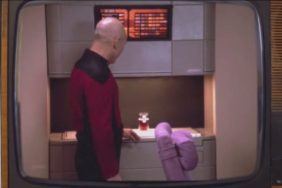Star Trek has, at least since the days of Next Generation, been notoriously meticulous in its depiction of future technology. The makers of the shows and movies would often consult scientists and engineers to make sure that they had all their bases covered, so to speak, when it came to creating fictional widgets and warp drives. Much credit goes to Michael and Denise Okuda.
Check Out: Interview | Screenwriter Doug Jung on Star Trek Beyond
However ginger they were with technology, however, Star Trek still had to notoriously fudge a lot of the smaller details, especially the chronology and its views of the way technology would move forward from the present. On its chronology, the original showrunners wanted to ensure that the exact year was unclear, so Gene Roddenberry invented the notion of “stardates.” By Next Generation, however, it was stated that it was the 24th century. 2364, to be exact. Which means we now had a timeline. Which means we had to start putting the chronology and technology of Star Trek into perspective. Which means certain events in Star Trek definitely haven’t happened yet, and technology is evolving wrongly.
Indeed, there’s a lot Star Trek has had to fudge over the years. Since lists are fun, here’s a list of things that Star Trek got wrong.
The Eugenics Wars

Paramount
Khan, as played by Ricardo Montalban (Star Trek II: The Wrath of Khan) and Benedict Cumberbatch (Star Trek Into Darkness), alludes to a time in Earth history when genetically enhanced humans attempted to overthrow the Earth. It was called the Eugenics War. Khan was a dangerous war criminal, cryogenically frozen, who was left over from wartime. The Wars were also talked about in a notable story arc on Enterprise. The problem is, to make the chronology work out, the writers of the original show set the Eugenics Wars in 1992, lasting until 1996. I graduated high school in 1996, and I don’t recall there being any Eugenics Wars. World War III, meanwhile, is slated for 2049, so hang tight.
Eugenics in General

Paramount
Star Trek‘s view of “augments” is, as time progresses, a bit out of date. In Star Trek II, and other places, it has been posited that genetically altered people are considered to be illegal and gauche, and there’s even an entire subplot running through Deep Space Nine about how one of the characters has to wrestle with his unwanted genetic enhancement. We are already eating GMOs in the present day, though. People live longer in the future, and it can only be due to genetic tinkering. The notion of genetic manipulation being a negative is already fading. I guess we’ll have to wait until 1992 to see if the Eugenics Wars change our view of things.
An Explosion of Macrotechnology

Paramount
In the 1960s, humanity was obsessed with reaching the Moon. America and Russia were engaged in a space race, and both nations were working furtively to make bigger and better travel machines. Travel machines – that is, macrotechnology – had been booming ever since the Industrial Revolution, and we invented planes, trains, and automobiles. By Star Trek‘s logic, that boom would have simply continued into the future, and spacecraft would be readily available quickly enough. Here in the present, though, we turned away from macrotechnology to focus on microtechnology. Now we find ourselves in an era where actually going places is gauche, and microchips and computers are the main focus of things. This was a criticism raised in the movie Tomorrowland. We don’t have jetpacks, but we do have iPhones. Unless we start using our smartphones to invent better spacecraft, Star Trek will never happen.
Transparent Aluminum

Paramount
Star Trek has always had a great deal of fun faffing about with time travel, which has opened a can of worms of causality and temporal problems. Star Trek IV: The Voyage Home took place largely in the present day, 1986, where our future crew had traveled back in time to rescue a pair of humpback whales from the Monterey Bay Aquarium. Yeah, that was a weird story. To make a tank for the whales, Scotty (James Doohan) entreated a modern-day engineer to make him some transparent aluminum and tainting the timeline be damned. That was in 1986. Surely, by 2016, the secret would be out. Right? Or do we have transparent aluminum and no one’s telling?
That Old Fermi Paradox

Paramount
The Drake Equation posits that, given the true vastness of space, there are definitely other intelligent life forms – forms we could conceivably communicate with – out there in the world. The Fermi Paradox, however, posits that if there are intelligent beings in the world, at least one of them would have advanced their technology far enough to have reached Earth by now. I will actually give Star Trek the benefit of the doubt on this one. It posits that an alien race, the Vulcans, will visit us in 2063. Maybe it will just take those aliens a little longer to get here than we thought. Indeed, given the age of the Milky Way (13.21 billion years), that last 47 years is practically upon us.
Leningrad

Paramount
This was a passing reference in Star Trek IV: The Voyage Home, but someone made reference to the city of Leningrad, which is the second largest city in all of Russia. Leningrad was originally named St. Petersburg, was changed to Petrograd in 1914, and settled on Leningrad in 1924. In 1986, the time Trek IV was released, it was still Leningrad. In 1990, however, Russia experienced a coup, the Communist regime fell, and the city went back to being called St. Petersburg. Oops. Perhaps Trek IV is asserting that Russia will experience a resurgence in Communism at some point in the future, and St. Petersburg will go back to being Leningrad.
Transporters

Paramount
This is a general complaint about Star Trek tech. In the TV show Enterprise, set in 2151, it is posited that transporters are a relatively new technology, and over the course of the series, they reveal how dangerous it is to use on living beings. In 1966, the transporters were inserted into the original show as a way to save on special effects; they didn’t have the budget to film a shuttlecraft landing on a new planet every week. Of all the technologies on Star Trek, the transporters are the most farfetched, and, as far as I know, no present day technology is even close to what we saw on the show. We have communicators already, and screen-to-screen communication is in our pockets.
Top Image: Paramount
Witney Seibold is a contributor to the CraveOnline Film Channel, and the co-host of The B-Movies Podcast and Canceled Too Soon. He also contributes to Legion of Leia and to Blumhouse. You can follow him on “The Twitter” at @WitneySeibold, where he is slowly losing his mind.








